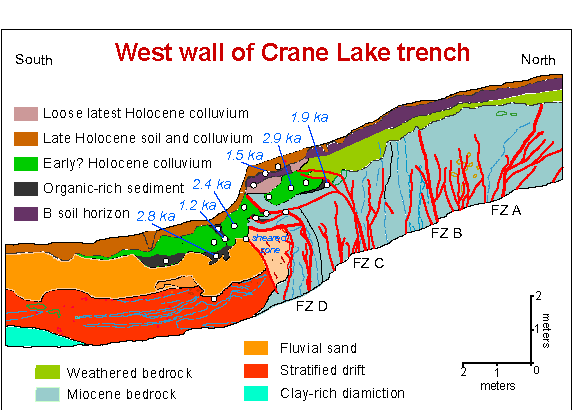|
Zhongwei-Tongxin Fault
The Zhongwei-Tongxin fault or Tianjingshan fault is an arcuate sinistral (left-lateral) strike-slip zone, forming one of the major structures on the northeastern margin of Tibetan plateau. Six paleoearthquake events in the past 14,000 years have been recorded along the Zhongwei-Tongxin fault zone. Among the earthquakes recorded are the 1622 North Guyuan earthquake, which had a magnitude of 7.0 and mid-seismogenic depth of about , the 1709 Zhongwei earthquake, which had a magnitude of 7.5. Tectonic setting The Zhongwei-Tongxin fault is one of the structures that accommodates the eastward spreading of the thickened crust of the Tibetan Plateau, the result of the ongoing collision between the Indian Plate and the Eurasian Plate. The northeastern margin of the Tibetan Plateau is marked by a combination of sinistral (left-lateral) strike-slip faults and thrust faults. The largest of the strike-slip faults is the 1,000 km long WNW–ESE trending Haiyan fault, which links to the east with ... [...More Info...] [...Related Items...] OR: [Wikipedia] [Google] [Baidu] |
Strike-slip
In geology, a fault is a planar fracture or discontinuity in a volume of rock across which there has been significant displacement as a result of rock-mass movements. Large faults within Earth's crust result from the action of plate tectonic forces, with the largest forming the boundaries between the plates, such as the megathrust faults of subduction zones or transform faults. Energy release associated with rapid movement on active faults is the cause of most earthquakes. Faults may also displace slowly, by aseismic creep. A ''fault plane'' is the plane that represents the fracture surface of a fault. A '' fault trace'' or ''fault line'' is a place where the fault can be seen or mapped on the surface. A fault trace is also the line commonly plotted on geologic maps to represent a fault. A ''fault zone'' is a cluster of parallel faults. However, the term is also used for the zone of crushed rock along a single fault. Prolonged motion along closely spaced faults can bl ... [...More Info...] [...Related Items...] OR: [Wikipedia] [Google] [Baidu] |
Qilian Shan
The Qilian Mountains (, also romanized as Tsilien; Mongghul: Chileb), together with the Altyn-Tagh (Altun Shan) also known as Nan Shan (, literally "Southern Mountains"), as it is to the south of Hexi Corridor, is a northern outlier of the Kunlun Mountains, forming the border between Qinghai and the Gansu provinces of northern China. Geography The range stretches from the south of Dunhuang some 800 km to the southeast, forming the northeastern escarpment of the Tibetan Plateau and the southwestern border of the Hexi Corridor. The eponymous Qilian Shan peak, situated some 60 km south of Jiuquan, at , rises to 5,547 m. It is the highest peak of the main range, but there are two higher peaks further south, Kangze'gyai at wit5,808 mand Qaidam Shan peak at wit5,759 m Other major peaks include Gangshiqia Peak in the east. The Nan-Shan range continues to the west as Yema Shan (5,250 m) and Altun Shan (Altyn Tagh) (5,798 m). To the east, it passes north of Qingha ... [...More Info...] [...Related Items...] OR: [Wikipedia] [Google] [Baidu] |
Before Present
Before Present (BP) years, or "years before present", is a time scale used mainly in archaeology, geology and other scientific disciplines to specify when events occurred relative to the origin of practical radiocarbon dating in the 1950s. Because the "present" time changes, standard practice is to use 1 January 1950 as the commencement date ( epoch) of the age scale. The abbreviation "BP" has been interpreted retrospectively as "Before Physics", which refers to the time before nuclear weapons testing artificially altered the proportion of the carbon isotopes in the atmosphere, which scientists must now account for. In a convention that is not always observed, many sources restrict the use of BP dates to those produced with radiocarbon dating; the alternative notation RCYBP stands for the explicit "radio carbon years before present". Usage The BP scale is sometimes used for dates established by means other than radiocarbon dating, such as stratigraphy. This usage differs from ... [...More Info...] [...Related Items...] OR: [Wikipedia] [Google] [Baidu] |
Paleoseismic
Paleoseismology looks at geologic sediments and rocks, for signs of ancient earthquakes. It is used to supplement seismic monitoring, for the calculation of seismic hazard. Paleoseismology is usually restricted to geologic regimes that have undergone continuous sediment creation for the last few thousand years, such as swamps, lakes, river beds and shorelines. In this typical example, a trench is dug in an active sedimentation regime. Evidence of thrust faulting can be seen in the walls of the trench. It becomes a matter of deducting the relative age of each fault, by cross-cutting patterns. The faults can be dated in absolute terms, if there is dateable carbon, or human artifacts. Many notable discoveries have been made using the techniques of paleoseismology. For example, there is a common misconception that having many smaller earthquakes can somehow 'relieve' a major fault such as the San Andreas Fault, and reduce the chance of a major earthquake. It is now known ( ... [...More Info...] [...Related Items...] OR: [Wikipedia] [Google] [Baidu] |
Radiocarbon Dating
Radiocarbon dating (also referred to as carbon dating or carbon-14 dating) is a method for determining the age of an object containing organic material by using the properties of radiocarbon, a radioactive isotope of carbon. The method was developed in the late 1940s at the University of Chicago by Willard Libby. It is based on the fact that radiocarbon () is constantly being created in the Earth's atmosphere by the interaction of cosmic rays with atmospheric nitrogen. The resulting combines with atmospheric oxygen to form radioactive carbon dioxide, which is incorporated into plants by photosynthesis; animals then acquire by eating the plants. When the animal or plant dies, it stops exchanging carbon with its environment, and thereafter the amount of it contains begins to decrease as the undergoes radioactive decay. Measuring the amount of in a sample from a dead plant or animal, such as a piece of wood or a fragment of bone, provides information that can be used to ... [...More Info...] [...Related Items...] OR: [Wikipedia] [Google] [Baidu] |
Optically Stimulated Luminescence
In physics, optically stimulated luminescence (OSL) is a method for measuring doses from ionizing radiation. It is used in at least two applications: * Luminescence dating of ancient materials: mainly geological sediments and sometimes fired pottery, bricks etc., although in the latter case thermoluminescence dating is used more often * Radiation dosimetry, which is the measurement of accumulated radiation dose in the tissues of health care, nuclear, research and other workers, as well as in building materials in regions of nuclear disaster The method makes use of electrons trapped between the valence and conduction bands in the crystalline structure of certain minerals (most commonly quartz and feldspar). The trapping sites are imperfections of the lattice — impurities or defects. The ionizing radiation produces electron-hole pairs: Electrons are in the conduction band and holes in the valence band. The electrons that have been excited to the conduction band may become entr ... [...More Info...] [...Related Items...] OR: [Wikipedia] [Google] [Baidu] |
Global Positioning System
The Global Positioning System (GPS), originally Navstar GPS, is a satellite-based radionavigation system owned by the United States government and operated by the United States Space Force. It is one of the global navigation satellite systems (GNSS) that provides geolocation and time information to a GPS receiver anywhere on or near the Earth where there is an unobstructed line of sight to four or more GPS satellites. It does not require the user to transmit any data, and operates independently of any telephonic or Internet reception, though these technologies can enhance the usefulness of the GPS positioning information. It provides critical positioning capabilities to military, civil, and commercial users around the world. Although the United States government created, controls and maintains the GPS system, it is freely accessible to anyone with a GPS receiver. The GPS project was started by the U.S. Department of Defense in 1973. The first prototype spacecraft wa ... [...More Info...] [...Related Items...] OR: [Wikipedia] [Google] [Baidu] |
Tongxin
Tongxin County (, Xiao'erjing: طْوثٍ ثِيًا) is a county under the administration of the prefecture-level city of Wuzhong in the central part of the Ningxia Hui Autonomous Region of the People's Republic of China, bordering Gansu province to the east. It has a total area of 7,021 square kilometers with a population of approximately 360,000 people. Characteristics Due to its topography, Tongxin County's economic conditions and foundation are extremely poor, and the county is often stricken by drought. However, farmers still make up two-thirds of the county's population. The county government has sought to use high technological methods to improve the standard of living in the region. The county government is located in the town of Tongxin. History In his ''Red Star Over China'', Edgar Snow mentions visiting the small towns of Yuwang Bao and Yuwang (, ) located in today's Tongxin County. At the moment (summer/fall 1936), Yuwang Bao was the location of the headquarters ... [...More Info...] [...Related Items...] OR: [Wikipedia] [Google] [Baidu] |
Jingtai County
Jingtai County () is a county in the middle of Gansu Province, bordering Inner Mongolia to the north. It is under the administration of Baiyin City and located at its northwest end. Covering an area of , it governs 8 towns and 3 townships, which then in turn govern 15 residential communities and 135 administrative villages. Its postal code is 730400, and its population as of the 2010 Chinese Census was 225,755 people, which the county government reports has grown to about 238,900 as of 2019. It is located at the junction of Gansu, Ningxia, and Inner Mongolia. Historically, it was a military hub, a vital communication center on the Silk Road, an important ferry, and also a major transit route to Hexi, Xinjiang, Ningxia, and Inner Mongolia. Since 1933, the name of the county has been ''Jingtai'' (), which means "prosperity of the scene, peace of the country and the people". The county is largely hilly and mountainous, with an elevation ranging from to above sea level. The ... [...More Info...] [...Related Items...] OR: [Wikipedia] [Google] [Baidu] |
Gulang Fault
Gulang County () is a county in central Gansu province, the People's Republic of China, bordering Inner Mongolia to the northeast. It is under the administration of Wuwei City. Its postal code is 733100, and its population in 2006 was 393,200 people. Located in the east of the Hexi Corridor and to the south of the Tengger Desert, it borders Jingtai County to the east, Tianzhu County to the south, Liangzhou District to the northwest, and Inner Mongolia's Alxa Left Banner to the northeast. Geography The county has a total area of and . It features a cold desert climate, with an annual mean temperature of and the annual evaporation of exceeding the annual precipitation of around ; annual sunshine duration is hours. Climate History Evidence has been found of Gulang being inhabited 4000 years ago, during the Neolithic. Administrative divisions Gulang County is divided to 15 towns and 4 townships. ;Towns ;Townships Economy The main economy is agriculture, with 36560 ... [...More Info...] [...Related Items...] OR: [Wikipedia] [Google] [Baidu] |





